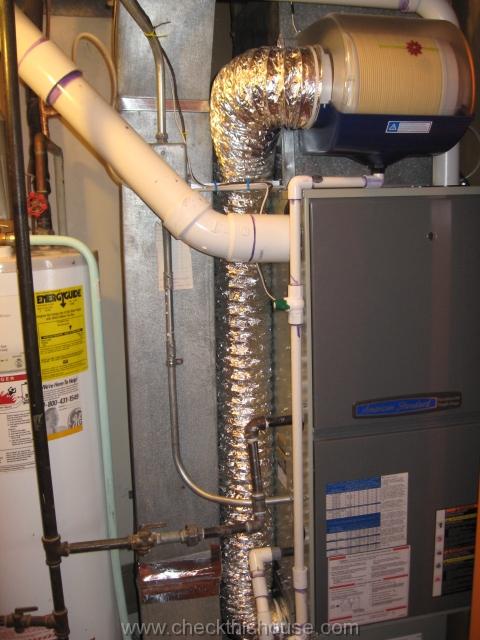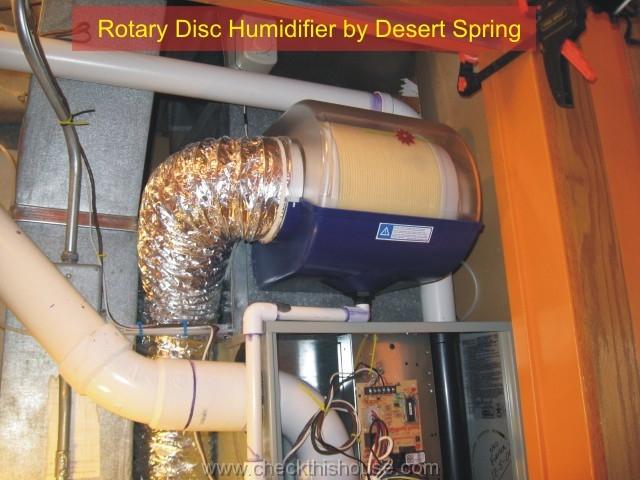It’s been almost one month since I’ve finished the installation, so it’s time for my Rotary Disc Humidifier by Desert Spring Review. I was a little hesitant before buying it and concerned with the other not-so-happy owners, but have finally come up with some answers I hope will help.
Let’s start this rotary disc humidifier by desert spring review from describing my environment:
- House sq footage – 2200
- House type – 2 story colonial, on slab (no basement or crawlspace)
- Furnace type – New American Standard, high efficiency down-flow, 80000 BTU
- Difficulty of the Rotary Disc Humidifier installation – easy with right tools, as it is most likely with every type of the whole house humidifiers
 Rotary Disc Humidifier review – design flaws – overall design is very clean, parts easily accessible and removable for maintenance purposes. The only thing so far that I don’t like is the float switch assembly height adjustment. To achieve maximum performance from the Rotary Disc Humidifier, its plastic disc’s outer ring has to be fully submerged in water. However, there is a vertical slot in the plastic basin where the floating switch is attached, which allows for a small adjustment of its height.
Rotary Disc Humidifier review – design flaws – overall design is very clean, parts easily accessible and removable for maintenance purposes. The only thing so far that I don’t like is the float switch assembly height adjustment. To achieve maximum performance from the Rotary Disc Humidifier, its plastic disc’s outer ring has to be fully submerged in water. However, there is a vertical slot in the plastic basin where the floating switch is attached, which allows for a small adjustment of its height.
For a properly installed / leveled Rotary Disc Humidifier, this level will never change, and the position of the floating switch is in the top section of the slot. In such an installation, the rubber float seal installed on the Rotary Disc Humidifier basin exterior wall does not provide a watertight seal. Almost every time the basin starts filling up, water finds its way under the rubber float seal bottom section and drips on … whatever you have underneath.
It’s easy to overcome this problem by installing another washer (same shape as the rubber one) made out of thin plastic on the floating switch side of the basin. Placing the rubber seal on that inner side of the Rotary Disc Humidifier basin doesn’t work too well because of the basin slot and float valve design. You can also use a small piece of an aluminum duct tape. Just tape the slot on the basin inside wall and cut a little opening for the floating valve assembly on the upper section of the slot.
 Rotary Disc Humidifier by Desert Spring Review – motor – there are 3 possible ways of controlling the humidifier motor operation.
Rotary Disc Humidifier by Desert Spring Review – motor – there are 3 possible ways of controlling the humidifier motor operation.
- The humidifier comes equipped with a 24VAC plug-in type transformer
- You can use a furnace 24VAC transformer to supply the Rotary Disc Humidifier’s power – follow the furnace manufacturer instructions
- You can connect a Rotary Disc Humidifier motor and humidistat directly to the furnace control board in which case the appliance will operate only when the furnace burners are on – same as above, follow the manufacturer requirements.
 Rotary Disc Humidifier Review – motor burnout – I believe that it occurs in the first two wiring options, and the reason is very simple. This is only based on my own observations – I was running the Rotary Disc Humidifier with its own transformer plugged into the electrical outlet for 3 days. Prior to this installation, my house humidity level was controlled by one portable humidifier, running constantly, and it never went over 36% at 69°F on second floor (humidifier installed on second floor), and about 34% on the first floor (it’s been a cold / dry winter in Illinois).
Rotary Disc Humidifier Review – motor burnout – I believe that it occurs in the first two wiring options, and the reason is very simple. This is only based on my own observations – I was running the Rotary Disc Humidifier with its own transformer plugged into the electrical outlet for 3 days. Prior to this installation, my house humidity level was controlled by one portable humidifier, running constantly, and it never went over 36% at 69°F on second floor (humidifier installed on second floor), and about 34% on the first floor (it’s been a cold / dry winter in Illinois).
I set the humidistat to 50% humidity hoping to get to at least 40% and turned the furnace blower to ON position for a little more dramatic … instant effect. It seemed like during the first 10 hours, the humidity level went up by 2%. Unfortunately, it stayed at that 2% for the remaining 3 days – with the Rotary Disc Humidifier’s motor and the furnace blower running constantly, and furnace burners turning ON at an average 15 minute intervals (exterior temperature in the 15°-20°F range).
So, with the furnace blower either ON or OFF, your Rotary Disc Humidifier will run almost constantly, eventually burning the motor, because it will rarely reach (if ever) the 50% setting. In my house, it never went over 38%…
The optimal performance of the drum or disc style humidifiers is achieved with a hot furnace heat exchanger, when water particles are vaporized before they actually hit the heat exchanger. The problem with running the blower and the Rotary Disc Humidifier (besides burning up the humidifier motor) is the moisture that will not evaporate on a cold furnace and will accelerate heat exchanger corrosion. So, I personally don’t like the setup with the direct transformer power feed.
 The third option for the Rotary Disc Humidifier connection, which turns the disk’s motor only when the furnace burners (and the blower) are on, would be perfect, but for some reason the appliance doesn’t perform as expected.
The third option for the Rotary Disc Humidifier connection, which turns the disk’s motor only when the furnace burners (and the blower) are on, would be perfect, but for some reason the appliance doesn’t perform as expected.
At first, I thought that my humidity-measuring device is malfunctioning, so I went and purchased another one, then I borrowed a third one from my neighbor… same results, between 35%-38%
Rotary Disc Humidifier Review – efficiency – I’m pretty sure that water usage is very low (this part I didn’t measure), so this is most likely right at the manufacturers description.

 Rotary Disc Humidifier Review – cleaning – this will depend completely on your water type, source, and filtering devices – like every type of humidifier, this one also needs maintenance. I’m very close to Chicago and on Lake Michigan water, which should be very well purified. What you see on the picture is after 24 days of running the humidifier and draining the basin every 4 days.
Rotary Disc Humidifier Review – cleaning – this will depend completely on your water type, source, and filtering devices – like every type of humidifier, this one also needs maintenance. I’m very close to Chicago and on Lake Michigan water, which should be very well purified. What you see on the picture is after 24 days of running the humidifier and draining the basin every 4 days.
Rotary Disc Humidifier by Desert Spring Review final thoughts
- Part of the humidifier’s performance problem might be caused by my high efficiency furnace, and its two heat exchangers … However, the Rotary Disc Humidifier manufacturer, Desert Spring, does not specify that this product should not be used or may not perform as described with a high efficiency furnace.
- I would most likely install a steam whole house humidifier by Honeywell but because of my furnace setup, this is not possible.
- Maybe with a different furnace type, its layout, and a smaller house, Rotary Disc Humidifier would work much better.
That concludes my Rotary Disc Humidifier by Desert Spring Review, I’ll get back to you next season…




I installed a Desert Spring humidifier on my gas furnace a few years ago. I had the same results–it ran 100% of the time, trying to reach the setpoint of 50%. This meant that my furnace blower ran 100% of the time. I even tried adding a few drops of dishwashing liquid to the water reservior to decrease surface tension of the water and try to get more water onto the spinning disks. This “humidifier” was never able to get my house to even 40% relative humidity. I have sealed/weatherized my house extensively which should have given this humidifier a fighting chance (according to my gas company’s online bill comparison to nearby houses of similar size my house has “very low” energy use). After the first winter I noticed that the case of the little 24 VAC motor that is used to turn the disks was severely corroded/rusted. When I tried to use it the next winter, the motor didn’t work. It was still within the 1 year warranty, and I called Desert Spring twice for a replacement motor and they never sent it.
I removed the flawed humidifier and installed a Honeywell Tru Steam humidifier on the duct exiting my furnace. I also installed the Honeywell digital humidistat in the first floor of my house, near the thermostat, and I bought the external temp/humidity sensor, which is wired to the humidistat and the humidistat automatically reduces the humidity setpoint when the outside temperature is very cold to eliminate condensation in the walls. I LOVE MY HONEYWELL TRUESTEAM HUMIDIFIER!!! It actually humidifies the house. Minimal maintenance required: I change the water line scale filter and clean the water tank every year.